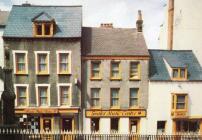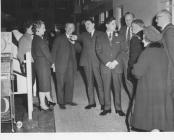Gellir lawrlwytho cynnwys at ddefnydd anfasnachol, megis defnydd personol neu ar gyfer adnoddau addysgol.
Ar gyfer defnydd masnachol cysyllwch yn uniongyrchol gyda deilydd yr hawlfraint os gwelwch yn dda.
Read more about the The Creative Archive Licence.
Disgrifiad
Denomination: Anglican
Dedication: St Issel(l)
Built: 13th century (chancel)
Restored: 1862-64
Photography: Christopher Wright
Date: 9 April 2001
Camera: Olympus C3000 Zoom digital
Note 1: Saundersfoot was known in medieval Wales as Llanussyllt and after the Norman conquest as St Issels (sometimes Issells), both after the parish church dedicated to the Welsh Saint Issel. Its bishop or abbot was considered one of the seven principal clerics of Dyfed under medieval Welsh law. [Source: Wikipedia online encyclopedia (accessed 12 October 2014)]
Note 2: St Issell's church has its origins in pre-Norman times. Issell is said to have been the father of St Teilo and the dedication may show that the foundation is a very early one, associated with a group of pre-conquest churches dedicated to Teilo and focused on a mother church at Penally. St Issell's has some surviving medieval fabric, including its 13th century chancel arch and a fine 14th or 15th century tower. Most of the medieval church was however lost during the large-scale restoration carried out between 1862 and 1864. Inside the church are a number of stained glass windows dedicated to former residents of the Hean Castle estate, including members of the Vickerman and Lewis families. St Issell's stands in an extensive churchyard, although the original boundary may have enclosed a much smaller area than is presently used. A stream running through the churchyard, to the west of the church, may have originally marked the boundary. A larger area to the west of the stream has been used for burial since the 19th century. A modern extension to the graveyard has been added to the southeast, on the opposite side of the road which links the church to Hean Castle. The graves of prominent local landowners and industrialists can be seen here, including C.R Vickerman and members of the Stokes and Lewis families of Hean Castle. [Source: Saundersfoot & District Historical Society website, where further details are available]
Image 1:
St Issel's and its graveyard, viewed from the west.
Note 3:St Issell's stands in an extensive churchyard, although the original boundary may have enclosed a much smaller area than is presently used. A stream running through the churchyard, to the west of the church, may have originally marked the boundary. A larger area to the west of the stream has been used for burial since the 19th century. [Source: Saundersfoot & District Historical Society website, where further details are available]
Image 2:
St Issel's Church, viewed from the south.
Image 3:
Decorated late-Norman font.
Image 4:
High altar and east window.
Image 5:
Silver goblet.
Note 4: St Issell's has been a Grade II* listed building since 1971; see the British Listed Buildings website for full details.














Oes gennych chi wybodaeth ychwanegol am yr eitem hon? Gadewch sylwad isod
Sylwadau (0)
Rhaid mewngofnodi i bostio sylw